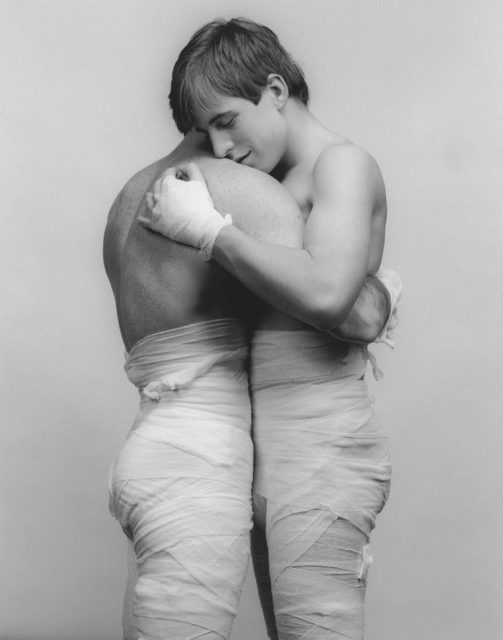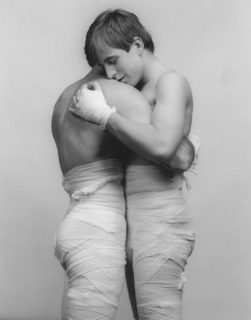While looking through the Davidson College Gallery archive, I had a difficult time deciding which piece to write about and where it fit in in my experience working in the gallery. I considered a fascinating and complicated Victor Vasarely print composed of deep purple, red and white. However, I have always been drawn to photography, specifically photographs of people, both candid and posed. So, I chose a work by American photographer Robert Mapplethorpe (1946-1989) entitled White Gauze. Some people argue that photography is not “true art” and that only painting and sculpture constitute forms of artistic creation, but Mapplethorpe proves this is not the case.
We are lucky enough to have White Gauze, a serious and important work, in the Galleries archive. It is a black and white photograph (characteristic of Mapplethorpe’s work) of two men embracing. The bottom halves of their bodies are wrapped in thin, white, gauze-like material, while their upper halves are exposed. The men are locked in a sensual embrace and one rests his head on the other’s shoulder with his eyes closed. Their connection is palpable as soon as the viewer sees the work. As I continued to look at it, I noticed the details of their bodies and how they were locked together in this hold. Their hands are also wrapped in gauze which, in my opinion, forces the viewer to focus more on the details of their exposed body parts such as chiseled backs and arms.
Although Mapplethorpe is known for his photographs of nude men like this one, his original muse was rock star singer and writer Patti Smith. In fact, she published a book entitled Just Kids about her deep friendship and romantic relationship with Mapplethorpe when they were in fact “just kids” in downtown New York City. Later in his career, though, Mapplethorpe focused on his nude photography. Some photographs are of one man, or in this case of two men connected in a powerful embrace. I would argue Mapplethorpe is most famous for these sorts of photographs. It is clear that he was fascinated and inspired by the nude human body, both male and female. The movie Mapplethorpe: Look at the Pictures goes into more detail about why the artist was so connected to bodily representations of his models.
Although Smith and Mapplethorpe continued to have a profound friendship later in life, Mapplethorpe also had romantic relationships with men, many of whom were his models. This gives context to the explicit sexuality or sexual chemistry in this photograph. By the late 70’s and early 80’s, Mapplethorpe became somewhat radical and controversial as he pushed conventional artistic boundaries by photographing the New York S&M scene. Despite this reputation, he was extremely successful and has had exhibitions in galleries all over the world; prominent museums also hold his work in their permanent collections.
I am excited to announce that this piece will be moved out of the gallery archive and into a prominent spot on campus for everyone to see. “White Gauze” will hang against the white walls of Chambers for the Davidson community to confront and enjoy. Mapplethorpe was diagnosed with HIV/AIDS in 1986 and died just two years later in 1988. Despite his sickness, Mapplethorpe continued to work and create until his death. It is fitting that “White Gauze” will be on campus on World Aids Day as a tribute to one of the most famous and well known American artists.


